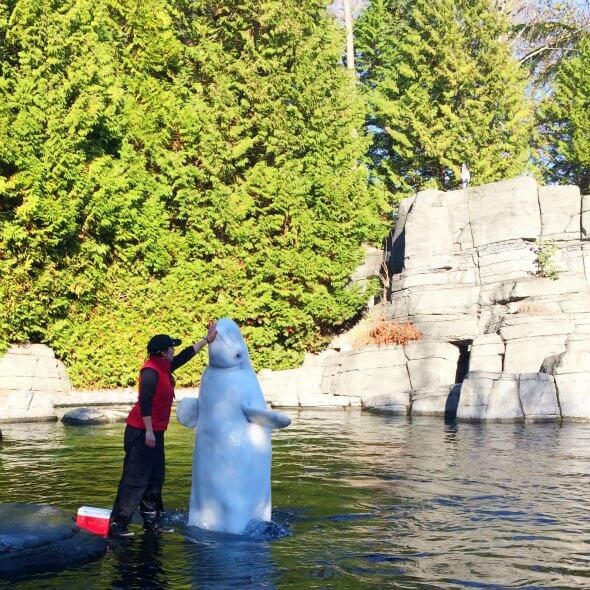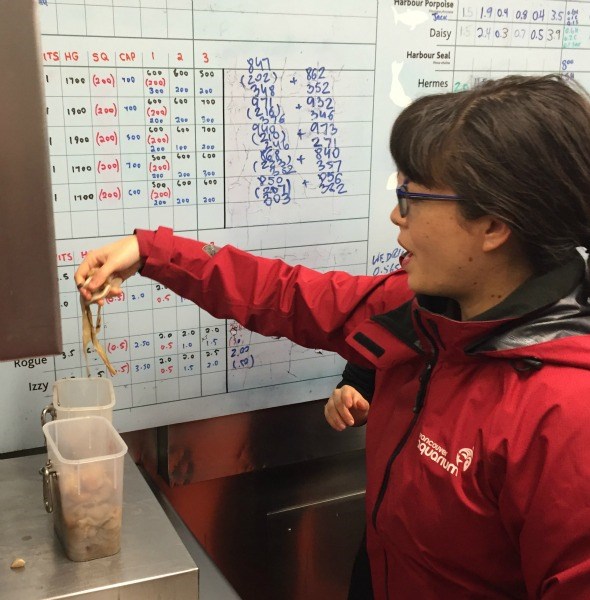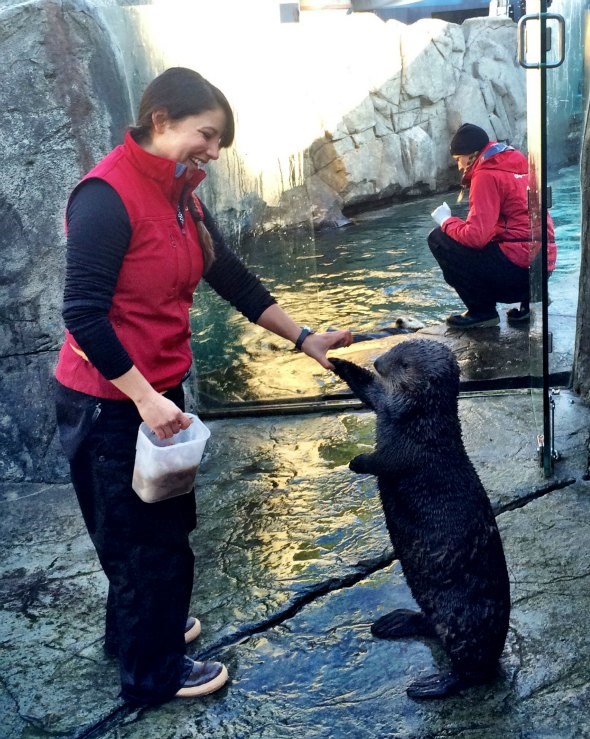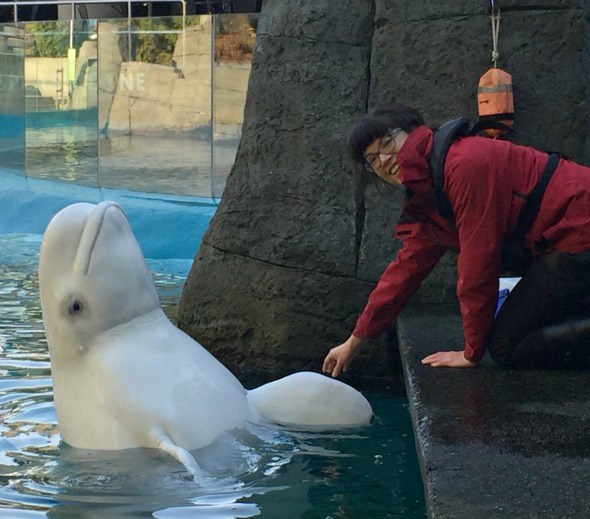From the mysterious to the masters of their craft, âThis Job Rocksâ is where I walk in someone elseâs work shoes. On Twitter and Instagram #ThisJobRocksYVR.
Some offices are windowless, some open onto foliage, and at the Â鶹´«Ã½Ó³»Aquarium, the marine mammal trainers have an underwater view into the dolphin habitat where Chester, a rescued false killer whale and Helen, a rescued Pacific, white-sided dolphin live. It was cold morning when I arrived to work with Nicky Garza, a marine mammal trainer and energetic animal advocate. Seeing as I was the only one fazed to be watching Chester and Helen swimming around and peering into the office, we went to work.

Outfitted in rain boots and a red rain jacket, Iâm whisked into the commercial kitchen where food prep is already underway. Up next, buckets for the sea otters. Otters eat 1/4 of their body weight in seafood every day. Clams, squid, prawns and whitefish comprise their seafood tower, 100% of it restaurant grade quality. I had the honour of helping make Wallyâs bucket. As it turns out, otters have their own particular pickinesses and I was instructed not to include any âclam gutsâ in his buckets.
Sadly, as I was getting ready to publish this post last week, Wally passed away. Wally, a blind sea otter from Tofino, was discovered with shotgun pellet wounds to his face and body. He was rescued by the Â鶹´«Ã½Ó³»Aquarium in 2013. I will always remember fondly how Nicky took so much care in breaking Wallyâs food into smaller bite size pieces, and when a piece was too big, Wally let Nicky know by batting it away. You could tell how much Nicky cared about Wally and I can only imagine how much they all miss him now. He will be missed by everyone who had the pleasure of meeting him, including me.
After prep, we scrub down the commercial kitchenâs stainless steel countertops and sinks, just one of the trainerâs many daily maintenance duties. Nicky tells me one of her favourite parts of her job also involves cleaning. âDive cleaning,â as itâs referred to, is a regular event where trainers suit up in full scuba gear and brandishing a giant, motorized scrubber, clean away all of the debris and algae buildup in the habitats. I lift the machine. Itâs heavy. Definitely no need for a workout after a day working here.
You can hear the pure joy Nicky has for all of the facets of her job, from cleaning and feeding as a daily caregiver to helping in conservation efforts. Every day, she gets to build a relationship with these special animals. âWho gets to say that they get to come to work to interact with the animals and that they want to interact with you too?â

Originally from Texas, Nicky has always wanted to be around animals and to take care of them. She earned a degree in animal science before working at the Dallas and San Francisco Zooâs with tigers, lemurs, otters, polar bears, grizzly bears, spectacled bears, chimps, and multiple species of monkeys. After volunteering in the Â鶹´«Ã½Ó³»Aquariumâs fish house and Marine Mammal Rescue Centre, she landed a coveted internship and eventually a full time position. She spends much of her spare time volunteering for various organizations including rehabbing abused and neglected horses in Langley, supporting the wolves and bears on Grouse Mountain.
We make a pitstop in the huge, walk-in freezer stacked to the gills (pun intended) with enough seafood to satiate the animalsâ hearty appetites. My eyes fixate on the muffin trays, piled high. Theyâre full of âprawnciclesâ â the otters' favourite frozen treats. We grab a few and, through a maze of underground and under pool walkways, emerge at the otterâs home. Tanu, Elfin and Katmai await us. There is a hint of surprise in the air as the trainers have baked variety into their work routines. The sea critters never know what to expect when a trainer arrives: it could be a training session, a feeding, or perhaps playtime.
Because the Â鶹´«Ã½Ó³»Aquarium is a research and conservation facility, resident trainers also assist visiting researchers. Currently, research is underway to understand the effects of increased shipping in the Arctic on beluga whales in the region. From of the deep dives belugas must make to avoid coming into contact with these huge vessels to how belugas communicate with each other, Nicky explains, âOur animals serve as a baseline for field researchers. The animals at the Â鶹´«Ã½Ó³»Aquarium are ambassadors that help us better understand aquatic life and the work that needs to be done to conserve them.â

Following the morning beluga show, starring Aurora and Qila along with Nicky and another trainer, we pick out toys for a playdate with two rescued harbour porpoises. To simulate ocean play, the team has cleverly reimagined toys from familiar seascapes: kelp, made out of industrial felt, like what youâd drive through in a carwash, a buoy exercise ball, or a starfish fashioned from a frisbee and fabric. We head into Jack and Daisyâs habitat and kneel near the edge of the pool. It doesnât take long before Jack is rubbing up against the felt starfish Iâm holding. As we leave, I catch a glimpse of Jack nudging the starfish into his enclave. Nicky catches my surprised expression and smiles, âPretty neat, hey?â
You can with one of the many animals including Aurora and Qila, the belugas or Elfin and Tanu, the sea otters.



